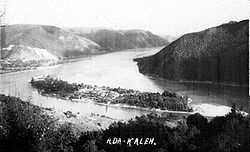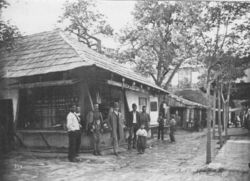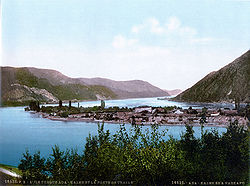
Ada Kaleh
Encyclopedia



Turkish language
Turkish is a language spoken as a native language by over 83 million people worldwide, making it the most commonly spoken of the Turkic languages. Its speakers are located predominantly in Turkey and Northern Cyprus with smaller groups in Iraq, Greece, Bulgaria, the Republic of Macedonia, Kosovo,...
: Adakale "Island Fortress", ) was a small island on the Danube
Danube
The Danube is a river in the Central Europe and the Europe's second longest river after the Volga. It is classified as an international waterway....
populated mostly by Turks
Turks of Romania
Turks in Romania, also known as Romanian Turks, are ethnic Turks who form an ethnic minority in Romania. According to the 2002 census, there were 32,098 Turks living in the country, forming a minority of some 0.2% of the population.- History :...
that was submerged during the construction of the Iron Gates hydroelectric plant in 1970. The island was about 3 km downstream from Orşova
Orsova
Orșova is a port city on the Danube river in southwestern Romania's Mehedinți County. It is one of four localities in the county located in the Banat historical region. It is situated just above the Iron Gates, on the spot where the Cerna River meets the Danube.- History :The first documented...
and measured 1.75 by 0.4–0.5 km.
The isle of Ada Kaleh is probably the most evocative victim of the Iron Gate
Iron Gate (Danube)
The Iron Gates The gorge lies between Romania in the north and Serbia in the south. At this point, the river separates the southern Carpathian Mountains from the northwestern foothills of the Balkan Mountains. The Romanian, Hungarian, Slovakian, Turkish, German and Bulgarian names literally mean...
dam's construction. A Turkish
Turkey
Turkey , known officially as the Republic of Turkey , is a Eurasian country located in Western Asia and in East Thrace in Southeastern Europe...
enclave, it had a mosque
Mosque
A mosque is a place of worship for followers of Islam. The word is likely to have entered the English language through French , from Portuguese , from Spanish , and from Berber , ultimately originating in — . The Arabic word masjid literally means a place of prostration...
and numerous twisting alleys, and was known as a free port
Free port
A free port or free zone , sometimes also called a bonded area is a port, port area or other area with relaxed jurisdiction with respect to the country of location...
and a smuggler's nest. Many other ethnic groups lived here beside the Turks.
History
The AustriaAustria
Austria , officially the Republic of Austria , is a landlocked country of roughly 8.4 million people in Central Europe. It is bordered by the Czech Republic and Germany to the north, Slovakia and Hungary to the east, Slovenia and Italy to the south, and Switzerland and Liechtenstein to the...
ns built a Vauban-type fort
Fortification
Fortifications are military constructions and buildings designed for defence in warfare and military bases. Humans have constructed defensive works for many thousands of years, in a variety of increasingly complex designs...
there to defend it from the Ottoman Empire
Ottoman Empire
The Ottoman EmpireIt was usually referred to as the "Ottoman Empire", the "Turkish Empire", the "Ottoman Caliphate" or more commonly "Turkey" by its contemporaries...
, and that fort would remain a bone of contention for the two empires. In 1699 the island came under Turkish control; but from 1716 to 1738 it was recaptured by the Austrians, and the Fortress of New Orsova was built by Nicolaus Doxat de Démoret, an Austrian colonel of Swiss origin. After a four-month siege in 1738 it was Turkish again, followed by the Austrians re-conquering it in 1789, but they had to return the island to the Turks with the Treaty of Sistova
Treaty of Sistova
The Treaty of Sistova ended the Austro-Turkish War between the Ottoman Empire and Austria. It was signed in Sistova in present-day Bulgaria on August 4, 1791....
on August 4, 1791, which ended the Austro-Turkish War (1787–1791) (and, by extension, the Ottoman–Habsburg wars) between the Ottoman Empire and Habsburg Monarchy
Habsburg Monarchy
The Habsburg Monarchy covered the territories ruled by the junior Austrian branch of the House of Habsburg , and then by the successor House of Habsburg-Lorraine , between 1526 and 1867/1918. The Imperial capital was Vienna, except from 1583 to 1611, when it was moved to Prague...
. Thereafter, the island lost its military importance.
In 1804, during the First Serbian Uprising
First Serbian Uprising
The First Serbian Uprising was the first stage of the Serbian Revolution , the successful wars of independence that lasted for 9 years and approximately 9 months , during which Serbia perceived itself as an independent state for the first time after more than three centuries of Ottoman rule and...
, Serbian
Serbs
The Serbs are a South Slavic ethnic group of the Balkans and southern Central Europe. Serbs are located mainly in Serbia, Montenegro and Bosnia and Herzegovina, and form a sizable minority in Croatia, the Republic of Macedonia and Slovenia. Likewise, Serbs are an officially recognized minority in...
rebels, led by Milenko Stojković
Milenko Stojkovic
Milenko Stojković was a Bimbasha Bimbashi in the First Serbian Uprising early in the 19th century...
, caught and executed the "Dahias", the Janissary
Janissary
The Janissaries were infantry units that formed the Ottoman sultan's household troops and bodyguards...
junta, who had fled Belgrade
Belgrade
Belgrade is the capital and largest city of Serbia. It is located at the confluence of the Sava and Danube rivers, where the Pannonian Plain meets the Balkans. According to official results of Census 2011, the city has a population of 1,639,121. It is one of the 15 largest cities in Europe...
and taken refuge on the island.
Even though the Ottoman Turks lost the areas surrounding the island after the Russo-Turkish War (1877–1878) (and the Romanian War of Independence
Romanian War of Independence
The Romanian War of Independence is the name used in Romanian historiography to refer to the 1877-1878 Russo-Turkish war, following which Romania, fighting on the Russian side, gained independence from the Ottoman Empire...
which was a part of the same conflict) the island was totally forgotten during the peace talks at the Congress of Berlin
Congress of Berlin
The Congress of Berlin was a meeting of the European Great Powers' and the Ottoman Empire's leading statesmen in Berlin in 1878. In the wake of the Russo-Turkish War of 1877–78, the meeting's aim was to reorganize the countries of the Balkans...
in 1878, which allowed it to remain a de jure
De jure
De jure is an expression that means "concerning law", as contrasted with de facto, which means "concerning fact".De jure = 'Legally', De facto = 'In fact'....
Turkish territory and the Ottoman Sultan's private possession until the Treaty of Lausanne
Treaty of Lausanne
The Treaty of Lausanne was a peace treaty signed in Lausanne, Switzerland on 24 July 1923, that settled the Anatolian and East Thracian parts of the partitioning of the Ottoman Empire. The treaty of Lausanne was ratified by the Greek government on 11 February 1924, by the Turkish government on 31...
in 1923 (de facto
De facto
De facto is a Latin expression that means "concerning fact." In law, it often means "in practice but not necessarily ordained by law" or "in practice or actuality, but not officially established." It is commonly used in contrast to de jure when referring to matters of law, governance, or...
until the Hungarian Kingdom unilaterally declared its sovereignty on the island in 1913.)
Between 1878 and 1918 the areas surrounding the island were controlled by Austria-Hungary
Austria-Hungary
Austria-Hungary , more formally known as the Kingdoms and Lands Represented in the Imperial Council and the Lands of the Holy Hungarian Crown of Saint Stephen, was a constitutional monarchic union between the crowns of the Austrian Empire and the Kingdom of Hungary in...
, but the island's inhabitants (officially citizens of the Ottoman Empire
Ottoman Empire
The Ottoman EmpireIt was usually referred to as the "Ottoman Empire", the "Turkish Empire", the "Ottoman Caliphate" or more commonly "Turkey" by its contemporaries...
) enjoyed exemption from tax
Tax
To tax is to impose a financial charge or other levy upon a taxpayer by a state or the functional equivalent of a state such that failure to pay is punishable by law. Taxes are also imposed by many subnational entities...
es and customs and were not subject to conscription
Conscription
Conscription is the compulsory enlistment of people in some sort of national service, most often military service. Conscription dates back to antiquity and continues in some countries to the present day under various names...
. The islanders also had the right to vote
Suffrage
Suffrage, political franchise, or simply the franchise, distinct from mere voting rights, is the civil right to vote gained through the democratic process...
during the Ottoman general elections of 1908
Second Constitutional Era (Ottoman Empire)
The Second Constitutional Era of the Ottoman Empire began shortly after Sultan Abdülhamid II restored the constitutional monarchy after the 1908 Young Turk Revolution. The period established many political groups...
following the Young Turk Revolution
Young Turk Revolution
The Young Turk Revolution of 1908 reversed the suspension of the Ottoman parliament by Sultan Abdul Hamid II, marking the onset of the Second Constitutional Era...
.
On May 12, 1913, the island was occupied by the forces of the Hungarian Kingdom of Austria-Hungary
Austria-Hungary
Austria-Hungary , more formally known as the Kingdoms and Lands Represented in the Imperial Council and the Lands of the Holy Hungarian Crown of Saint Stephen, was a constitutional monarchic union between the crowns of the Austrian Empire and the Kingdom of Hungary in...
. It thus became known as Újorsova in the Krassó-Szörény County. This was one of the last unilateral territorial expansions of Hungary before the outbreak of the First World War; the seizure was never officially recognized by the Ottoman government.
Romania
Romania
Romania is a country located at the crossroads of Central and Southeastern Europe, on the Lower Danube, within and outside the Carpathian arch, bordering on the Black Sea...
unilaterally declared its sovereignty in 1919 and strengthened its claim with the Treaty of Trianon
Treaty of Trianon
The Treaty of Trianon was the peace agreement signed in 1920, at the end of World War I, between the Allies of World War I and Hungary . The treaty greatly redefined and reduced Hungary's borders. From its borders before World War I, it lost 72% of its territory, which was reduced from to...
in 1920. On July 24, 1923, Turkey
Turkey
Turkey , known officially as the Republic of Turkey , is a Eurasian country located in Western Asia and in East Thrace in Southeastern Europe...
officially ceded Ada Kaleh to Romania
Romania
Romania is a country located at the crossroads of Central and Southeastern Europe, on the Lower Danube, within and outside the Carpathian arch, bordering on the Black Sea...
with Articles 25 and 26 of the Treaty of Lausanne
Treaty of Lausanne
The Treaty of Lausanne was a peace treaty signed in Lausanne, Switzerland on 24 July 1923, that settled the Anatolian and East Thracian parts of the partitioning of the Ottoman Empire. The treaty of Lausanne was ratified by the Greek government on 11 February 1924, by the Turkish government on 31...
; by formally recognizing the related provisions in the Treaty of Trianon.
The island was visited by King Carol II of Romania
Carol II of Romania
Carol II reigned as King of Romania from 8 June 1930 until 6 September 1940. Eldest son of Ferdinand, King of Romania, and his wife, Queen Marie, a daughter of Prince Alfred, Duke of Edinburgh, the second eldest son of Queen Victoria...
in 1931, and by Prime Minister Süleyman Demirel
Süleyman Demirel
Sami Süleyman Gündoğdu Demirel, better known as Süleyman Demirel , is a Turkish politician who served as Prime Minister seven times and was the ninth President of Turkey.-Life:Demirel was born in İslamköy, a town in Isparta Province...
of Turkey
Turkey
Turkey , known officially as the Republic of Turkey , is a Eurasian country located in Western Asia and in East Thrace in Southeastern Europe...
on September 13, 1967.
The population lived primarily on the cultivation of tobacco and fishery, and later on tourism. In its last years of existence, the island's population ranged between 600 and 1,000 inhabitants.
The Ada Kaleh Mosque
Mosque
A mosque is a place of worship for followers of Islam. The word is likely to have entered the English language through French , from Portuguese , from Spanish , and from Berber , ultimately originating in — . The Arabic word masjid literally means a place of prostration...
, dating from 1903, was built on the site of an earlier Franciscan
Franciscan
Most Franciscans are members of Roman Catholic religious orders founded by Saint Francis of Assisi. Besides Roman Catholic communities, there are also Old Catholic, Anglican, Lutheran, ecumenical and Non-denominational Franciscan communities....
monastery
Monastery
Monastery denotes the building, or complex of buildings, that houses a room reserved for prayer as well as the domestic quarters and workplace of monastics, whether monks or nuns, and whether living in community or alone .Monasteries may vary greatly in size – a small dwelling accommodating only...
. The carpet of the mosque, a gift from the Turkish Sultan Abdülhamid II
Abdul Hamid II
His Imperial Majesty, The Sultan Abdülhamid II, Emperor of the Ottomans, Caliph of the Faithful was the 34th sultan of the Ottoman Empire...
, was relocated to the Constanţa
Constanta
Constanța is the oldest extant city in Romania, founded around 600 BC. The city is located in the Dobruja region of Romania, on the Black Sea coast. It is the capital of Constanța County and the largest city in the region....
Mosque in 1965.
Aftermath
During the construction of the dam, some of the structures that were built on the island were relocated to the nearby Şimian Island, including part of the masonry of the fortress' catacombs, the Mosque, the bazaar, Mahmut Pasha's house, the graveyard and various other objects. However, the Ada Kaleh community decided to emigrate to TurkeyTurkey
Turkey , known officially as the Republic of Turkey , is a Eurasian country located in Western Asia and in East Thrace in Southeastern Europe...
after the evacuation of the island, instead of re-settling on Şimian Island. Also, a smaller part went to Dobruja
Dobruja
Dobruja is a historical region shared by Bulgaria and Romania, located between the lower Danube river and the Black Sea, including the Danube Delta, Romanian coast and the northernmost part of the Bulgarian coast...
, another Romanian territory with a Turkish minority
Turks of Romania
Turks in Romania, also known as Romanian Turks, are ethnic Turks who form an ethnic minority in Romania. According to the 2002 census, there were 32,098 Turks living in the country, forming a minority of some 0.2% of the population.- History :...
, so the reconstruction of the "New Ada Kaleh" was never completed.
Literature
Ada Kaleh plays an important part in the novel of one of the most famous Hungarian authors, Mór JókaiMór Jókai
Mór Jókai , born Móric Jókay de Ásva , outside Hungary also known as Maurus Jokai, was a Hungarian dramatist and novelist.-Early life:...
. In the novel "Man of Gold" (Arany Ember), published in 1872, Ada Kaleh is called the "No one's Isle" and it becomes an almost mythical symbol of peace, seclusion and beauty, juxtaposed with the material outside world. In Between the Woods and the Water, the second volume of Patrick Leigh Fermor
Patrick Leigh Fermor
Sir Patrick "Paddy" Michael Leigh Fermor, DSO, OBE was a British author, scholar and soldier, who played a prominent role behind the lines in the Cretan resistance during World War II. He was widely regarded as "Britain's greatest living travel writer", with books including his classic A Time of...
's narrative of his Mittel European walking tour in the mid 1930s, the author discusses the history of the island and describes a delightful visit with a group of elderly inhabitants.

